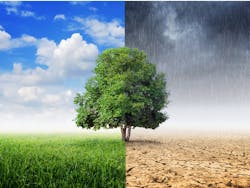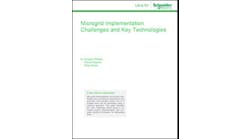Former Obama Sustainability Chief Seeks Microgrid Resilience for Vulnerable Communities
The Obama administration’s former chief sustainability officer, Michelle Moore, hopes to bring microgrid resilience to disadvantaged communities through non-profit project developer Groundswell.
In addition to leading sustainability efforts for the federal government, Moore has been active in expanding the green building movement globally. She is CEO of Groundswell, which focuses on bringing solar to low-income communities. But the organization is now focusing on microgrids, with its first projects planned for Baltimore and Atlanta.
Groundswell — which has brought community solar to more than 3,500 low and moderate income residents — is working in partnership with numerous groups.
Moore wants to address the fact that low-income neighborhoods often are located in areas hit hard by climate change and have sub-par infrastructure, compared to higher income neighborhoods.
“Lower income neighborhoods often are located in parts of a city that are more vulnerable to flooding or extreme heat from climate change,” she said. “Prioritizing low and moderate income communities with resilience as a service is important to economic health and well being.”
Overcoming disinvestment
Historically, low-income and Black neighborhoods have been targeted for underinvestment, she said.
“Our theory is that in neighborhoods that have systematic disinvestment, we don’t see as much infrastructure. There are more requirements for infrastructure upgrades.”
On the other hand, in wealthier or downtown areas of Washington D.C, for example, there are “shiny new infrastructure systems,” she said. “We want to work in neighborhoods that have suffered from disinvestment” and provide resilience.
The Atlanta and Baltimore projects aim to explore how to advance microgrids in both regulated and unregulated environments. Both projects involve solar, storage and microgrids, but the size of the systems has not yet been determined. The projects are still in the technical design phase, and construction won’t begin before the first quarter of 2021.
In the first project, Groundswell is working with the city of Baltimore in PJM’s territory to plan and design community resiliency hubs in vulnerable communities. The organization is trying to identify trusted locations where community members can gain access to reliable power for devices, learn about emergencies and store medications sensitive to temperature. To that end, Groundswell is collaborating with residents to identify locations that best suit them.
Learn more about Groundswell’s work at Microgrid 2020 Global in a special session: “Bringing it Home II: Community Microgrids of the Future” on November 18. Registration is free but space on the platform is limited.
“If you have a facility meant to serve as a shelter if the power goes off and people need refrigeration for medication, there are places where vulnerable people seek refuge,” she said. In some places, like government buildings, these residents won’t feel as safe, said Moore.
Baltimore resilience hubs
The Baltimore project began with a $300,000 grant from the Maryland Energy Administration awarded in June to design up to 30 resiliency hubs in the city’s most climate vulnerable areas.
The grant was part of a larger solicitation that led to 14 winners who will divvy up $1.05 million provided by the Resilient Maryland program. The funding will go toward completing detailed feasibility analyses, engineering, planning and design.
The state plans to identify up to 30 resiliency hub candidate sites by summer 2021.
Groundswell will look into where it’s feasible to install resilience hubs. An important part of that effort is identifying hub locations with the help of residents.
Baltimore is vulnerable to coastal storms, sea level rise, flooding, extreme heat and high winds, and these events are happening more often and reaping more damage.
“The hubs are stocked with essential supplies and are part of a network. We want to make community members aware, if there’s an extended power outage, that these locations exist. They could refrigerate medicines or insulin, for example,” said Moore.
The Baltimore project will explore selling power back to the grid to help pay for the installation, she noted.
Utility partnership in Atlanta
The Atlanta project, which also focuses on energy equity, aims to demonstrate how to advance renewable energy, storage and microgrid in partnership with the utility, Georgia Power, said Moore.
The US Department of Energy’s National Renewable Energy Laboratory in April selected Groundswell’s proposed resilience hub project, which will serve the Atlanta University Center Consortium — a consortium of African-American higher education institutions — to participate in a collaborative research effort.
Groundswell was one of eight teams selected to participate in the program, called the Solar Energy Innovation Network, which pulls together diverse teams to research challenges associated with adopting solar energy. The program intends to develop solar applications and other distributed energy resources in unique locations and contexts.
Groundswell will work with the Partnership for Southern Equity (PSE) and Spelman College.
As in the Baltimore project, the design of the hub will be community driven, with an eye on meeting the needs of Atlanta’s historic Black colleges and universities that are located in the Atlanta University Center.
Georgia Power will be part of the team that aims to design financial models that can be replicated.
The state functions under a regulated utility model, so third parties aren’t allowed to sell power, said Moore. George Power also does not offer net metering. That means Georgia Power will be an important player in helping identify financial models that will help such projects pencil out, said Moore.
Microgrids as part of toolkit for equity
Looking to the future, Groundswell aims to explore more ways to provide resilience to low-income communities. While Groundswell’s mission originally focused on just solar, the organization has found that to meet its mission, it needs to provide energy storage and microgrids.
“While these projects are still at the pioneering edge of most of the markets we serve, we envision a near-future when solar, energy storage and microgrids are part of the everyday toolkit for building equitable energy futures everywhere,” said Moore.
Track news about microgrid projects. Subscribe to the free Microgrid Knowledge newsletter.








